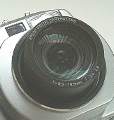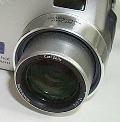Support | Learning Center | General Imaging Info
Understanding Digital Camera Lens Specifications
The lens is a critical component of the camera. Digital camera lenses
are small and need to be accurately manufactured. They contribute a lot
to the cost of the camera so specifications vary considerably. There are
also a number of different performance parameters that can be considered:
Zoom Range
The most obvious lens parameter is zoom range. It is very convenient to
be able to take wide angle and telephoto shots with the same camera. 3X
optical zoom is good, but fairly expensive. 2X also gives useful range
but is not usually so good if you like talking pictures of distant object
(wildlife and sports for example). Cameras with fixed focus lenses tend
to be easier to use and smaller. Some cameras also have a digital zoom
feature. All this does is enlarge the size of the picture (and crop it)
after it is taken. It does not capture more detail. Digital zoom can be
used to extend the optical zoom range, but always check the optical zoom
range, this is what really counts. Try the zoom in the store where you
buy the camera to see if you like the range.
Minimum focal length
In addition to the range of zoom, check out the minimum focal length (how
wide you can zoom out). Some digital cameras do not have good wide angle
operation because it is hard to make a wide angle lens for a CCD sensor.
Check the zoom range - less than 35mm is acceptable, 28mm is good (both
measured in 35mm equivalent focal length, see below).
Maximum F-stop
If you care about taking pictures in low light look at the maximum F-stop
your camera can support. There is an iris in the lens and this is a measurement
of the maximum it can open up, it affects the brightness of the image.
F/4 is not bad for digital camera lenses, f/2.8 is good. Maximum F-stop
can also vary a bit with zoom. High F-stop zoom lenses have very large
lenses at the front and would be heavier. F-stop also affects depth of
field, the range of distances for which the subject will be in focus.
To get a general impression of light gathering performance look at the
size of the lens at the front. Some cameras have tiny lenses - this means
that less light enters the lens and therefore the camera does not perform
so well in low light level.
Close ups
Some cameras can focus very close to the lens and be used as microscopes
(it is called 'macro' mode). If you like to take pictures of people and
landscape this does not matter. But if you like to take close-up subjects
(like flowers and plants) it is best to check this. Focus closer than
50cm (0.5m) is good.
Zoom lens scales
Lens focal lengths are measured in mm. The higher the number the more
the telephoto effect. The range is usually marked on the front of the
lens and appears in the specification sheet of the camera.
Since the CCD (the device used to collect the light) in the digital camera
is much smaller than a film camera then all the lenses and their focal
lengths are smaller too. A digital camera with a 6-15mm lens and a certain
size CCD has exactly the same range as a regular film camera with a 28-72mm
zoom lens. To further complicate the issue the sizes of CCDs used in cameras
are not all the same.
When everyone used 35mm film cameras it was easy to know the type of
lens as long as you knew the scale. To make it easier with digital cameras
many manufactures quote their zoom lenses in "35mm equivalent"
sizes, which is more convenient. In this case the '35mm' refers to the
width of the film used in traditional cameras. The following table shows
typical values:
Conventional 35mm
film camera |
Typical digital camera |
Range |
| <20mm |
< 4.3mm |
Very Wide angle |
| 21-35mm |
4.5-7.5mm |
Wide angle |
| 50mm |
10.7mm |
Normal - similar to what your eye would see |
| 70-200mm or more |
15-43mm |
Telephoto |
Use of different zoom settings has a strong effect on perspective in
the picture. Wide-angle lenses distort pictures of people faces and tend
to make them look fatter with larger noses!
Sometimes lenses are quoted as 2X or 3X. This refers to the range, so
a 25-50mm would be 2X and 25-75mm would be 3X. This measurement is used
more often for video cameras. When buying a camera keep in mind that X
values only yell you part of the story. You should also look at the range
covered; a 70-140mm lens would be 2X, but would not be able to photograph
close subjects, a 35-70mm lens is also 2X but would offer very different
performance.
Back
to General Imaging Info
|



